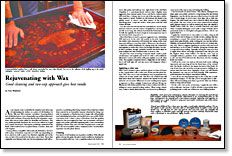Rejuvenating with Wax
Good cleaning and two-step approach give best results
Synopsis: Furniture restorer Tom Wisshack says a coat of paste wax is probably the simplest and the safest way of rejuvenating the surface on a piece of old furniture. In this article, he discusses how he cleans a piece of furniture and how he applies a wax polish, beginning with a color coat and then applying a harder clear wax over that. He uses a naphtha-soaked cloth to start, and he suggests more aggressive methods if the naphtha isn’t effective enough. He explains how to select the tint for the color coat, which brands to trust, and how to apply the color coat. A harder, clear coat is essential, and he details the application of that, too. Wisshack closes with a few problem cases and how to handle them.
A coat of paste wax is probably the simplest and safest way of rejuvenating the surface on a piece of old furniture. In the 18th and 19th centuries, varnished, French-polished and oil-finished pieces were all generally wax polished afterward, usually with a mixture of beeswax dissolved in turpentine, sometimes with various resins added for durability and hardness. This wax polish gradually hardened, the wood tone shifted as it aged and a patina developed. Subsequent polishings maintained the finish, which mellowed as it acquired minute scratches, dents and a bit of grime.
A wax polish is compatible with nearly all old finishes, but how well a piece of furniture responds to it will vary depending on how—and how well—a piece was finished originally and on the care (or lack of it) received by the piece since then. Pieces that originally were finished with care but not maintained well will respond to a polishing after being cleaned. Pieces that have either been restored in an insensitive manner (drenched in cheap varnish, for example) or finished poorly to begin with will probably need refinishing before they can benefit from a wax polish. I’ll discuss below how I clean a piece of furniture, from the gentlest method to the most aggressive that I can recommend, and how I apply a wax polish, generally beginning with a color coat and then applying a harder clear wax over that. Properly done, a wax polish is the most beautiful surface treatment in the woodworker’s repertoire.
Cleaning
Few pieces of old furniture are in perfect condition. If the dirt and grime obscure the grain, the piece needs a judicious cleaning before you polish with wax. I use a naphtha-soaked soft cloth to remove dirt, grime and built-up wax, right down to the old finish. (Naphtha is a petroleum-based solvent that’s slightly more aggressive than mineral spirits; if you can’t find it, mineral spirits will work fine.) I always start in an out-of-the-way place, preferring caution to speed. Finishes on old furniture are always completely cured, so there’s very little chance of the naphtha dissolving them. I wipe the surface of the piece until the cloth comes off clean.
I’ve also removed old wax and dirt with Liberon’s wood cleaner and wax remover (see the sources of supply box). As long as it’s not left on too long, this solvent won’t harm the finish layer either. As with the naphtha, it’s best to begin in an inconspicuous area to see how the finish responds to it.
From Fine Woodworking #99
For the full article, download the PDF below:
Fine Woodworking Recommended Products

Odie's Oil

Waterlox Original

Foam Brushes






















Log in or create an account to post a comment.
Sign up Log in